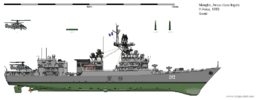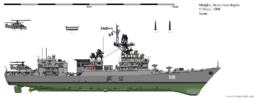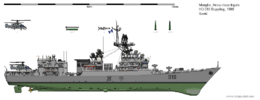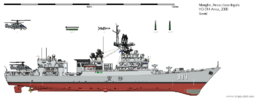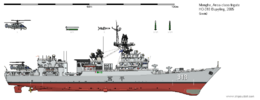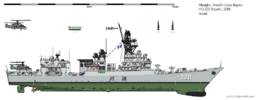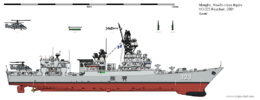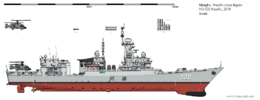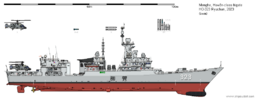Ansa-class frigate
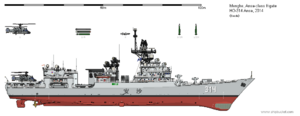 HO-314 Ansa following her mid-life refit.
| |
| Class overview | |
|---|---|
| Builders: |
|
| Operators: | Menghe |
| Preceded by: | none |
| Succeeded by: | Yechŏn-class frigate |
| Subclasses: | Hawŏn-class frigate |
| Built: | 1990-2001 |
| In commission: | 1993-present |
| Planned: | 10 |
| Completed: | 10 |
| Active: | 7 |
| Lost: | 2 |
| Scrapped: | 1 |
| General characteristics (Ansa, 2014) | |
| Type: | Frigate |
| Displacement: |
|
| Length: |
|
| Beam: | 13.7 m at waterline |
| Draught: |
|
| Propulsion: |
|
| Speed: | 32 knots |
| Range: | 6,200 nautical miles (11,400 km) at 18 knots |
| Complement: |
|
| Sensors and processing systems: |
|
| Electronic warfare & decoys: |
|
| Armament: |
|
| Aircraft carried: | 1 × GH-28DJN |
| Aviation facilities: |
|
The Ansa-class frigates (Menghean: 安沙級外層護衛艦 / 안사급 위충 호위함, Ansa-gŭb wichung howiham) are a class of frigate designed and built in Menghe during the 1990s. Ten ships were produced in total, though the last four are sometimes considered a separate Hawŏn class due to modifications made during construction. They were the first postwar Menghean surface combatants to be built as general-purpose escort ships, with balanced anti-air, anti-ship, and anti-submarine capabilities.
Development
The Ansa-class frigates were conceived of as general-purpose, well-rounded escort ships, which would sit on the outer edge of a high-value formation or convoy to protect it from air and submarine attack. During the design process they were known as Plan 308. In particular, they were intended as escorts for the newly-built aircraft carrier Haebang, which entered service in 1990, and as general-purpose escorts for formations of landing ships.
The Yobu-class destroyer Maepo, completed to a modified design after the Decembrist Revolution, served as a conceptual testbed for a number of solutions implemented on the Ansa class. In particular, Maepo's surface-to-air missile armament consisting of two single-arm YDG-37 launchers was carried forward into the Ansa class.
Initially, Menghean designers hoped to use a combined diesel or gas powerplant, to balance sprint speed and cruising efficiency. Dayashina, however, blocked sales of the LM2500 turbine via Tír Glas and Hallia, still concerned that Menghe's new regime could turn hostile to Dayashinese interests. A domestic all-diesel powerplant was considered next, but preliminary studies found that it offered inadequate speed at full power. Eventually, Menghe purchased M7 combined gas turbine units from Letnia, each one consisting of two 6,000 hp M60 turbines for cruising and two 18,000hp M3 turbines for sprint operations in a COGAG arrangement.
Characteristics (as built)
Sensors
Ansa-class ships carry a single HR-240 radar on the main sensor mast. This is a Menghean licensed version of the Letnian MR-710 Fregat ("Top Plate") radar system, with two angled 3D arrays and an IFF antenna above them. Unlike the Chŏndong and Yobu classes, there is no second radar unit for multi-frequency capability or redundancy; the aft sensor mast sports a fire-control antenna instead.
For underwater search, the first six ships carry an MG-332T "Titan-2T" active/passive hull sonar and an MG-325 "Vega" towed variable-depth sonar. These are upgraded versions of the sonar equipment carried on the Ginam and Hyŏngnam class ships.
Armament
The Ansa-class ships' main surface-to-air armament consists of two 3S90 "Uragan" single-arm missile launchers licensed from Letnia. The missile's Menghean designation is YDG-37. Each mount sits atop a magazine with 24 missiles, and takes 12 seconds to complete a full reloading cycle. The missile has a range of 30 kilometers. Each ship has four 3R90 illumination radars to guide these missiles, with two on each side of the superstructure.
Close-range air defense consists of two GBM-30/6 CIWS mounts, Menghe's licensed copy of the AK-630. These are arranged with one mount on each corner of the superstructure. There are only two corresponding MR-123 fire-control radars, each linked to two mounts, so the CIWS battery can only engage two targets at once - and in most directions, only with one gun at a time. Ansa was the first Menghean warship built with the GBM-30/6N variant of the mount, which has an electro-optical sight on the turret rather than a manual backup director. The 100mm gun turret on the foredeck also has anti-air and anti-missile capability.
Anti-submarine armament, shared with the Ginam, Hyŏngnam, and Chanjok Jachido classes, consists of two quadruple 533mm torpedo tube mounts, one on either side. The corresponding deck of the superstructure is partially cut away to allow these mounts to traverse. In addition to wire-guided homing torpedoes, these mounts can also launch the HŎ-2 Poksŏl anti-submarine standoff weapon. For close-range anti-submarine attacks, the ships also carry two RBU-6000 depth charge rocket projectors on the foredeck.
During construction of the first two ships, the design was modified to fit angled launch boxes for the YDH-24 anti-ship missile, which was still in development. Ansa was commissioned without AShM boxes; Wisin, Tongjin, and Gokhap were commissioned with a pair of two-missile boxes. During regular minor maintenance stops, all ships in the class were eventually fitted with twin and later quadruple launchers for the YDH-24.
Aircraft facilities
All Ansa-class ships are built with a landing pad and hangar for a GH-28 anti-submarine helicopter. Unlike the Ginam and Hyŏngnam classes, in which the hangar is recessed one deck into the hull with a partially sloped floor, the hangar on the Ansa class is at the same level as the landing pad. The landing pad also incorporates a hauldown winch which can assist in rough-weather landing operations and tow the recovered helicopter safely into the hangar.
Even with these changes, however, crews still complained that the hangar was relatively narrow, making repair and re-arming difficult. Multiple ships would also have to work together to keep one helicopter on station at all times between them.
Hawŏn subclass
While Hallia was unable to sell any equipment containing Glasic or Dayashinese parts to Menghe, it did export three advanced sonar suites in the early 1990s, for use on the Chanjok Jachido-class cruisers. When the lead ship of this class conducted at-sea trials and exercises in 1994 and 1995, both her bow-mounted sonar and towed sonar array were found to have vastly superior performance to the systems installed on the recently-completed Ansa. Menghe responded by signing a contract for eight additional Hallian sonar sets. Four of these would be used for the Pyŏng'an-class destroyers, which were still in the design phase; the other four would be mounted on future Ansa-class frigates, modified to make the best use of the new systems.
The first Ansa-class frigate to be completed with the new sonar arrangement was Hawŏn, commissioned in 2000. As such, in Menghe and abroad, the modified frigate design is sometimes known as the Hawŏn class. Externally, the Hawŏn-class ships are nearly identical to the first six units in the class, differing mainly in a slight extension to the quarterdeck. Internally, however, the aft sonar handling rooms follow an entirely different layout, as they are designed to carry a towed AN/SQR-19 array rather than a bulky sonar unit at the end of a cable. The sonar bulge under the bow was also modified to fit the AN/SQS-53B. In the course of the rearrangement of internal compartments, new fuel tanks were added, slightly extending range.
While they had markedly better sonar performance than the baseline Ansa class, the Hawŏn-class ships were in many respects an interim solution. In heavy seas, the bow sonar often lifted close to or above the surface, interfering in its search capability. For submarine-killing operations, the ships still relied on the HŎ-2, which alerted submarines to its launch by igniting the booster stage underwater. Finally, their use of single-arm missile launchers severely limited their rate of fire, as did the 30-kilometer range of the YDG-37 missile.
Refits and upgrades
While Ansa was commissioned without anti-ship missile armament, she was spotted in 1994 with two dual YDH-24 launch boxes mounted in the space between the bridge and the funnel. These were likely added during a routine maintenance period, and it is likely that Ansa was completed with the mounting locks for the launchers already in place. Subsequent ships were commissioned with either two dual or, later, two quadruple YDH-24 launch boxes.
After sustaining damage in the Ummayan Civil War, most notably an anti-ship missile hit at the base and rear of her hangar, HO-315 Wisin was rebuilt according to a modified plan. The taller, slab-sided hangar is the most distinctive difference, along with GBM-23/5 Bulkkot CIWS mounts on its flanks. The structures supporting these CIWS mounts are different from those seen on the refitted Hawŏn-class frigates in the 2020s. Although Wisin's variable-depth sonar unit was damaged in the fire that followed the missile impact, the Menghean Navy judged that a one-to-one replacement would be obsolete as procured, and a rebuild to support newer towed array sonar systems would require too many changes; hence, the VDS deployment hatch was plated over and the Wisin spent the rest of her service life without any towed sonar system. Because of this refit, Wisin was a unique ship for the remainder of her career.
As the ships approached their mid-life refits in 2010, the Navy drafted a series of plans to assess refits and modernization. A "Maximum Refit" proposal, issued for the Ansas, would thoroughly rebuild them to keep the class viable for another 25 years. The YDG-37 missile magazines would be replaced by Mark 41 VLS modules, for a total of 48 cells. All guidance and air search radars would be replaced, with two STIR 2.4 directors providing missile guidance and gun fire-control. The GBM-30/6 CIWS mounts would be replaced by GBM-23/5 Bulkkot mounts. The most extensive refits would be applied to the engine room, which was irregularly sized to fit the Letnian M3 COGAG turbine unit. Under the new plan, this would be replaced by a CODAG plant with one LM2500 unit flanked by two Samsan S9000H diesels in the forward machinery room and the gearing and transmission unit in the aft machinery room. Finally, the hull section which previously hosted the torpedo tubes would be extensively rebuilt to improve crew accommodations and structural integrity. Under such a refit plan, the Ansas were expected to achieve a similar level of on-paper capability as the Yechŏn-class frigates.
In the end, however, the Navy concluded that the cost of such a thorough overhaul was too high, and would be better spent procuring new frigates. The proposed engine room refit was particularly intensive, and would result in a cramped machinery compartment with a custom-built transmission. Replacing the forward sonar dome would be especially time-consuming, as the front section of the hull below the waterline would have to be cut away and rebuilt. Instead, the five remaining Ansa-class destroyers underwent a more modest refit and overhaul, receiving the HR-44 periscope search and self-defense radar and some minor updates to electronics.
The Hawŏn-class frigates, which already had more advanced sonar equipment, underwent a more thorough refit program. They retained their original powerplants, but their radar masts and armament sections were entirely rebuilt. The forward YDG-37 launcher was replaced by a 16-cell Mark 41 VLS module, and the aft launcher by an 8-cell module; the smaller module was necessary to provide adequate clearance forward of the bridge. The ships' sensor masts were rebuilt to use the SMART-S MK2 on the first three ships, along with the JJ-9 electronic warfare suite, Hongmoja passive EO/IR scanners, and new navigation radars. CPAR-X radar illuminators and a SIGINT/ELINT intercept mast brought the ships on par with the Chunchŏn-class frigates in sensor capability. Aft, the GBM-30/6 CIWS mounts were replaced with GBM-23/5 Bulkkot mounts, and four distributed 12.7mm HMG mounts were added for self-defense. Between the hangars were a pair of 350mm twin tubes for the YŎ-35/2 torpedo. HO-323 Ryuchan, the fourth ship of the Hawŏn subclass, entered refits later than her sisters, and received more modern equipment, including Dyura-J multifunction radar illuminators and a Thales NS100 air search radar. Following this refit, the four Hawŏn-class frigates are expected to remain in service for another 20 to 25 years, retiring from 2040 onwards.
Operational service
Polvokian Civil War
As part of Menghe's intervention in the Polvokian Civil War, HO-314 Ansa, HO-315 Wisin, and HO-316 Tongjin accompanied the Menghean aircraft carrier Haebang on a series of patrols off the south coast of Polvokia, escorting the carrier as her aircraft conducted patrols over the Polvokian capital of Ryŏngdo. None of the ships sustained damage during this operation, but their crews gained valuable experience in practical operations.
Ummayan Civil War
Four Ansa-class frigates accompanied the Menghean task force dispatched to Qusayn to support combat operations in neighboring Ummayah. At the Battle of the Aqaba Sea, HO-315 Wisin and HO-318 Bupyŏng both sustained hits from Anglian anti-ship missiles, Wisin at the base of her hangar and Bupyŏng amidships. The crew of the Wisin were able to extinguish the fires which broke out on the aft section of the ship, though she did suffer extensive damage and would be sent back to drydock for a substantial rebuild at the end of the war. Bupyŏng lost power soon after the missile impact, and as she was still in contested waters and unable to keep up with other retreating Menghean ships, her commander made the decision to scuttle the ship to prevent her capture.
Because of her battle damage, HO-315 Wisin underwent her mid-life reconstruction early, in 2005-2006. As a result of this earlier reconstruction, and because she had lost her towed sonar array, she was decommissioned ahead of schedule in 2016. A group of civilians led by the family members of the sailors who lost their lives in the 2005 missile attack petitioned the government to have the Wisin preserved as a museum ship, owing to her combat service and her unique construction. The Ministry of National Defense, however, was reluctant to permanently open the Wisin to the public, as at the time, she had four similarly-equipped sister ships still in service and could pose a security threat. Additionally, the citizens' group was unable to raise enough money to pay for the ship's preservation, including purchasing her from the breakers, securing a docking site, and converting her to a museum. For its part, the Navy recommended that Ansa be eventually preserved instead, for her value as the country's first post-revolution frigate class. The MoND concurred with this reasoning, and in 2017, the hull of the Wisin was towed to a scrapping facility and broken up.
One-Month War
By the start of the One-Month War in April 2022, four Ansa-class and four Hawŏn-class frigates were still in service, with HO-323 Ryuchan still undergoing refits and the four Ansas mainly relegated to rear-line escort duties. Brought into readiness before the war, HO-314 Ansa was tasked with escorting a convoy of supply ships bound for the Republic of Innominada, where she was accompanied by H-311 Yŏnju. On April 26th, HO-314 was engaged by the Anglian submarine HMS Agincourt while off the coast of Ryangnam Province. At the time of the attack, both ships' helicopters were being serviced, and both were fitted with old sonar systems, meaning that neither could detect the threat. After Yŏnju was sunk, Ansa began moving in the direction of the torpedoes, hammering on active sonar. This was a desperate move, intended to scare off the threat or buy time for the convoy to escape. Ansa successfully destroyed two incoming torpedoes with hardkill countermeasures fired from her HBDJ-21 series launchers, but sustained a hit from a third torpedo several minutes later. This torpedo is believed to have struck her sonar bulge, blowing off the bow of the ship but not sinking her outright; a watertight bulkhead within the hull was able to contain the flooding, and Ansa slowed to a crawl and deployed her towed VDS. Her captain gave the order to contain the flooding while keeping VDS and periscope detection radar active, in the hopes of suppressing the threat; an additional torpedo (some sources say two) finished her off, resulting in the loss of all but four crew members.
Ships in the class
In keeping with nomenclature practices for Menghean frigates, all Ansa-class and Hawŏn-class vessels are named for Menghean prefectures.
When the first two ships, Ansa and Wisin, were launched, the Menghean Navy still used the old nomenclature and classification system; these ships bore the hull type "H" (for howiham or "escort ship") and no permanent hull number. In 1995, the Menghean Navy introduced permanent hull numbers for all warships and reclassified the Ansa-class frigates as outer-layer escort ships, with the hull type HO (oechung howiham). Ansa and Wisin were retroactively given the hull numbers HO-314 and HO-315, respectively.
| Hull No. | Name | Mengja | Builder | Laid down | Launched | Commissioned | Status |
|---|---|---|---|---|---|---|---|
| Ansa subclass | |||||||
| HO-314 | Ansa | 安沙 | Kimhae | 1990-04-23 | 1991-06-29 | 1993-04-03 | Sunk by torpedoes from HMS Agincourt on 22 April 2022. |
| HO-315 | Wisin | 威信 | Kimhae | 1991-07-05 | 1992-09-25 | 1994-11-16 | Decommissioned in 2016; scrapped 2017-2018. |
| HO-316 | Tongjin | 通津 | Kimhae | 1992-10-04 | 1993-08-01 | 1995-09-13 | In service |
| HO-317 | Gokhap | 曲峽 | Kimhae | 1993-07-13 | 1994-06-16 | 1996-03-10 | In service |
| HO-318 | Bupyŏng | 富平 | Gyŏngsan | 1994-07-12 | 1995-07-25 | 1998-10-27 | Sunk by missiles from Anglian aircraft on 17 Mar 2005. |
| HO-319 | Nyŏmju | 恬州 | Kimhae | 1995-06-24 | 1996-03-01 | 1998-01-16 | In service |
| Hawŏn subclass | |||||||
| HO-320 | Hawŏn | 河源 | Gyŏngsan | 1996-09-12 | 1997-12-30 | 2000-03-10 | In service |
| HO-321 | Sabgyo | 揷橋 | Kimhae | 1997-09-21 | 1998-07-14 | 2000-06-16 | In service |
| HO-322 | Busin | 阜新 | Gyŏngsan | 1998-01-04 | 1999-05-20 | 2001-04-21 | In service |
| HO-323 | Ryuchan | 柳贊 | Kimhae | 1998-07-19 | 1999-11-03 | 2001-08-28 | In service |
Gallery
H Ansa (later HO-314) as commissioned, without YDH-24 launch boxes
HO-318 Bupyŏng as she appeared in 2005, when sunk by Anglian aircraft during the Ummayan Civil War
HO-320 Hawŏn as commissioned. Note that she was constructed with green anti-fouling paint but painted white above the waterline before her commissioning.


